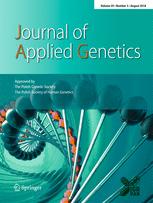Ver ítem
- xmlui.general.dspace_homeCentros Regionales y EEAsCentro Regional Santa FeEEA RafaelaArtículos científicosxmlui.ArtifactBrowser.ItemViewer.trail
- Inicio
- Centros Regionales y EEAs
- Centro Regional Santa Fe
- EEA Rafaela
- Artículos científicos
- Ver ítem
Survey of potential factors involved in the low frequency of CP5 and CP8 expression in Staphylococcus aureus isolates from mastitis of dairy cattle from Argentina, Chile, and Uruguay
Resumen
Staphylococcus aureus produces capsular polysaccharides (CPs) both in vivo and under defined culture conditions being serotypes 5 and 8 the most prevalent. S. aureus isolates that fail to produce CP5 or CP8 are defined as non-typeable (NT). Loss of capsule expression, however, may lead to S. aureus persistence in a chronically infected host. The prevalence of NT strains of S. aureus isolated from bovine mastitis varies according to the geographic origin
[ver mas...]
Staphylococcus aureus produces capsular polysaccharides (CPs) both in vivo and under defined culture conditions being serotypes 5 and 8 the most prevalent. S. aureus isolates that fail to produce CP5 or CP8 are defined as non-typeable (NT). Loss of capsule expression, however, may lead to S. aureus persistence in a chronically infected host. The prevalence of NT strains of S. aureus isolated from bovine mastitis varies according to the geographic origin of the strain. The aims of this work were to detect phenotypically and genotypically the capsular profile of 144 S. aureus isolated from bovine mastitis in Argentina, Chile, and Uruguay and explore the factors that are considered to be associated with capsule expression as presence of IS257, IScap, and agr typing of non-related collection. The detection of the IS257, IScap, cap genes, and agr typing was performed using PCR. The detection and quantification of capsular polysaccharide production were performed by ELISA assays. We found that 96% of the S. aureus isolates investigated carried cap5(8) genes but over 75% of strains do not express capsule in the three countries studied. However, only 6 isolates from Argentina carried the IScap element that totally suppressed the expression of the capsule, suggesting that other factors could influence on CP expression. Moreover, the agrI/NT association was statistically significant suggesting that this profile is a phenomenon observed not only in other parts of the world but also in our region.
[Cerrar]

Autor
Ambroggio, Maria Belen;
Perrig, Melina Soledad;
Camussone, Cecilia;
Pujato, Nazarena;
Bertón, Alicia;
Gianneechini, Edgardo;
Alvarez, Silvia;
Marcipar, Ivan Sergio;
Calvinho, Luis Fernando;
Barbagelata, Maria Sol;
Fuente
Journal of Applied Genetics 59 (3) : 357–363 (August 2018)
Fecha
2018-08
ISSN
1234-1983
2190-3883
2190-3883
Formato
pdf
Tipo de documento
artículo
Palabras Claves
Derechos de acceso
Embargado
 Excepto donde se diga explicitamente, este item se publica bajo la siguiente descripción: Creative Commons Attribution-NonCommercial-ShareAlike 2.5 Unported (CC BY-NC-SA 2.5)
Excepto donde se diga explicitamente, este item se publica bajo la siguiente descripción: Creative Commons Attribution-NonCommercial-ShareAlike 2.5 Unported (CC BY-NC-SA 2.5)

